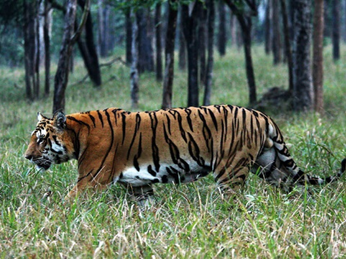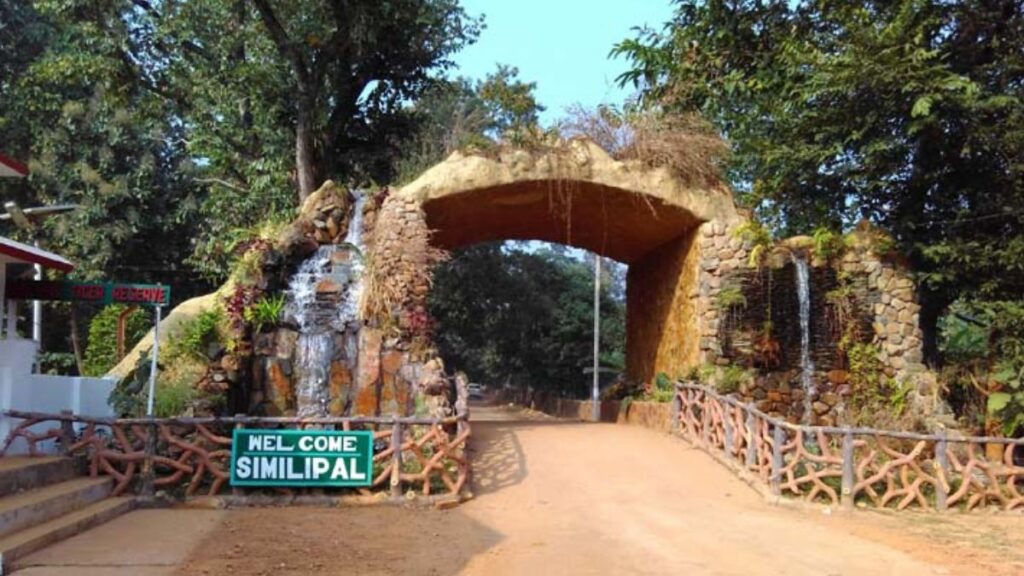Similipal Tiger Reserve is located in the Mayurbhanj district of Odisha, covering an area of approximately 2,750 square kilometres. It’s a place where you can enjoy nature without worrying about your phone signal—because who needs Instagram when you have real-life tigers, right? Established as a tiger reserve on December 31, 2007, Similipal also gained recognition as a UNESCO biosphere reserve on June 22, 1994, highlighting its significance in global biodiversity.
The name “Similipal” derives from the local word “Simul,” referring to the silk cotton trees that dominate the landscape. This region is not only a sanctuary for tigers but also a vital watershed area that sustains many rivers, contributing to the region’s ecological balance. So, you could say it’s quite the waterworks!
Similipal Tiger Reserve Biodiversity at Its Best


One of the most remarkable aspects of Similipal Tiger Reserve is its rich biodiversity. The reserve is home to a wide variety of species, including:
- Royal Bengal Tiger: The primary attraction of the reserve, these majestic creatures are the apex predators and play a crucial role in maintaining the ecological balance. Just remember: it’s a tiger, not a big, cuddly house cat!
- Various Species of Deer: Similipal houses several species of deer, including Sambar and Chital, which are vital to the food chain and ecosystem. If you catch one striking a pose, don’t forget to say “cheese!”
- Rich Birdlife: Birdwatchers will be delighted by the diverse avian population, which includes both resident and migratory species. Spotting colorful birds amidst the lush greenery is a rewarding experience—unless, of course, they decide to conduct their own karaoke session at dawn!
- Unique Plant Species: The reserve boasts a rich variety of flora, including medicinal plants, and numerous species of trees, adding to its ecological importance. Some plants even look like they could use a good haircut!
Similipal is divided into a critical tiger habitat and a buffer zone, allowing for effective conservation and management of wildlife populations. The reserve’s diverse ecosystems make it a paradise for nature lovers and researchers alike—just don’t try to research how many selfies you can take with the tigers!
More Read: Bhitarkanika National Park
The Story of Khairi: A Symbol of Conservation


Khairi was rescued after being abandoned near the Khairi River in Odisha on October 5, 1974. Saroj Raj Choudhury (conservationists and the Similipal National park’s founder) and his wife, Nihar Nalini Swain, adopted her. Khairi grew up with unique pets like a hyena and a bear.
Known for her gentle nature, she helped raise awareness about the struggles tigers face in the wild. Many people loved her story. She inspired local communities to protect their environment and wildlife.
Sadly, Khairi’s life ended early in 1981 due to rabies, which deeply affected Saroj. Today, she is remembered as an ambassador for wildlife conservation. Her story reminds us to protect these amazing animals and their homes.
We hope India’s wild animals will receive the same love and care Khairi did. Who knew one tiger could make such a big impact?
Know More About Khairi: The story of Khairi
How to Reach Similipal Tiger Reserve


Similipal Tiger Reserve is accessible by various means of transportation:
- By Road: The reserve is well-connected by road. The nearest major town is Baripada, which is about 35 kilometers away. Regular bus services operate from major cities in Odisha. Just don’t be surprised if your bus has more stops than a gossiping aunt!
- By Rail: The nearest railway station is Baripada, which is connected to other cities in Odisha. From Baripada, you can hire a taxi or take a bus to the reserve. Bonus points if your train is on time—now that’s a rare sight!
- By Air: The closest airport is Biju Patnaik International Airport in Bhubaneswar, approximately 250 kilometers away. From the airport, you can hire a taxi to reach the reserve. Just make sure to practice your “I’m on a tiger safari!” face for when you arrive!
Conservation Efforts and Challenges
Similipal Tiger Reserve is not just a sanctuary for wildlife; it is also a hub for various conservation initiatives. The government and several NGOs work tirelessly to implement conservation projects aimed at preserving the habitat and protecting the species that inhabit it.
Key conservation efforts include:
- Habitat Preservation: Protecting the forests and waterways is crucial for maintaining the ecological balance and ensuring the survival of diverse species. Think of it as nature’s version of spring cleaning!
- Anti-Poaching Measures: Strict measures are in place to combat poaching and illegal wildlife trade, which pose significant threats to tiger populations. Remember, poaching is like a really bad movie plot that we all want to avoid!
- Community Involvement: Engaging local communities in conservation efforts helps foster a sense of ownership and responsibility towards wildlife protection. After all, who better to help out than the folks who live next door to the tigers?
Despite these efforts, Similipal faces challenges such as habitat loss due to human encroachment and poaching. Ongoing conservation work is essential to safeguard the future of the reserve and its inhabitants.
Visitor Information
If you’re planning a trip to Similipal Tiger Reserve, here are some essential details to consider:
- Best Time to Visit: The ideal time to explore Similipal is between October and March when the weather is pleasant, and wildlife sightings are more frequent. Just don’t forget your sunscreen; you don’t want to come back looking like a boiled lobster!
- Entry Fees and Permits: Visitors need to obtain permits to enter the reserve. Fees may vary depending on the type of vehicle and the number of individuals in the group. Make sure you have your wallet ready—no cash, no wildlife adventure!
- Accommodations: There are various accommodation options available, ranging from forest lodges to guesthouses in nearby towns. It’s advisable to book in advance during peak seasons, unless you enjoy sleeping under the stars (with the occasional growl for company).
- Wildlife Spotting Tips: Early morning and late afternoon are the best times for wildlife spotting. Be patient and respectful of the animals and their habitats. And remember, stealth is key—try not to scare off your potential new furry friends!
More Reads: Satkosia Sand Resort
Conclusion
Similipal Tiger Reserve is not just a destination; it is a testament to the beauty and importance of wildlife conservation. Its rich biodiversity, captivating stories like that of Khairi, and ongoing conservation efforts make it a significant sanctuary for both wildlife and visitors alike. If you’re seeking a unique adventure that combines nature, wildlife, and a commitment to conservation, Similipal Tiger Reserve should be on your travel list.
So pack your bags, plan your trip, and immerse yourself in the beauty of this biodiversity haven. And don’t forget to share your experiences or plans to visit in the comments below—after all, it’s always fun to swap adventure stories, especially the ones that end with a tiger sighting!